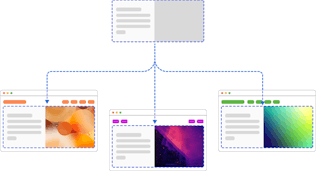No vendor lock-in
Traditional headless CMS platforms often restrict you to proprietary databases. CloudCannon, built on Git, keeps your content portable and fully under your control.
Search
CloudCannon is not your typical headless CMS. It’s designed for both developers and non-technical teams, providing a seamless content management experience without compromising on flexibility or control.

CloudCannon is a unique Git-based CMS that eliminates the vendor lock-in associated with API-driven systems.
You have full control over your content and code, housed directly in your Git repository. This means:
Seamless version control
Easy rollbacks
Work with your preferred tech stack.
For marketing teams and other non-technical users, CloudCannon provides a user-friendly visual editor.
Your team can see exactly how content updates will look on the live site — no guesswork required. So you can:
It’s important to me that CloudCannon is a Git-based CMS. I hate having a vendor lock with API-based CMSs — how can I trust anyone else with our data?
Traditional headless CMS platforms often restrict you to proprietary databases. CloudCannon, built on Git, keeps your content portable and fully under your control.
Non-technical users often struggle with CMSs, constantly needing developer support. With CloudCannon, marketing teams can work autonomously while developers focus on building new projects.
CloudCannon allows for rapid scaling and customization for your team, ideal for businesses with growing content needs or high traffic loads. Your team can build high-performance websites with full flexibility and scalability.

CloudCannon integrates directly with Git, giving your team the flexibility to push code and content simultaneously. It’s perfect for developers who value full control over their site’s infrastructure.
Bring Git workflows to content teams. Create branches, collaborate on changes, and publish updates to production. Both developers and content editors can work in parallel, increasing efficiency across teams.
Marketing teams can easily manage content with CloudCannon’s on-page Visual Editor. See changes in real time, ensuring no surprises and a lot of confidence when new content goes live.
Leverage CloudCannon’s multichannel capabilities to distribute content across web apps, mobile, digital signage, and more — all managed from a single source of truth in Git.

Try CloudCannon for your content management needs, or chat with one of the team